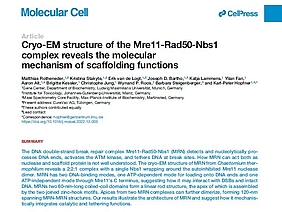New publication from the Hopfner lab on how MRN integrates catalytic and scaffolding functions
DNA double-strand breaks (DSBs) are a threat to genomic integrity throughout life. Un- or misrepaired DSBs can lead to cell death, chromosomal aberrations and tumorigenesis. The MRN (Mre11-Rad50-Nbs1) complex is a central DNA double-strand break repair factor that detects, tethers and nucleolytically processes DNA ends at break sites to initiate DSB repair pathways. The Hopfner group in collaboration with Christophe Jung, Wynand P. Roos and Barbara Steigenberger use cryo-electron microscopy in combination with various biochemical and cellular assays to decipher how the single protein complex MRN integrates all the above-mentioned functions. A full-length structure of Chaetomium thermophilum MRN reveals an asymmetric complex stoichiometry of a single Nbs1 wrapping around the autoinhibited Mre11 nuclease dimer. Nbs1 thereby stabilizes the globular head domain, consisting of two Mre11 and the globular parts of the Rad50 ATPase dimer, and regulates the transition to an active conformation. Further structural analysis showed the basis for DNA tethering: Rad50s long coiled-coil domains protruding from the head domain form rod-like assemblies that can dimerize via its zinc-hooks. Disturbing this interaction leads to severe DSB repair defects. Additional DNA binding studies unravel two modes for MRN, one dependent on the Mre11 C-terminus which likely resembles a scanning state in search for DSBs and the latter ATP dependent to recognize DNA ends.
Original publication:
Cryo-EM structure of the Mre11-Rad50-Nbs1 complex reveals the molecular mechanism of scaffolding functions
Rotheneder M, Stakyte K, van de Logt E,Bartho JD, Lammens K, Fan Y, Alt A, Kessler B, Jung C, Roos WP, Steigenberger B, Hopfner KP
Molecular Cell 2022 Dec 20;S1097-2765(22)01138-8. DOI: 10.1016/j.molcel.2022.12.003

